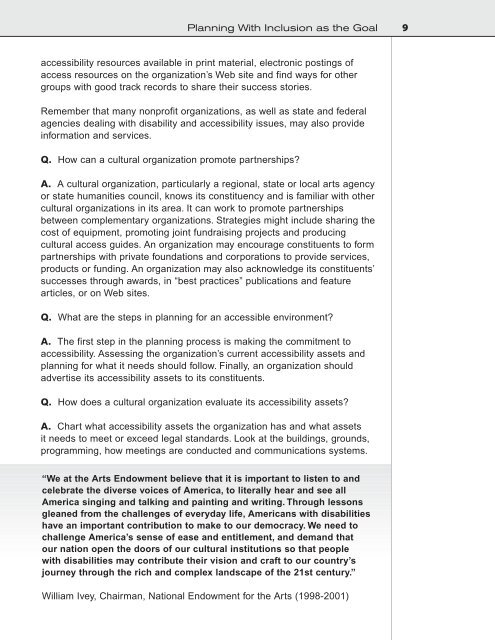Design for Accessibility: A Cultural Administrator's Handbook
Design for Accessibility: A Cultural Administrator's Handbook
Design for Accessibility: A Cultural Administrator's Handbook
You also want an ePaper? Increase the reach of your titles
YUMPU automatically turns print PDFs into web optimized ePapers that Google loves.
Planning With Inclusion as the Goal 9<br />
accessibility resources available in print material, electronic postings of<br />
access resources on the organization’s Web site and find ways <strong>for</strong> other<br />
groups with good track records to share their success stories.<br />
Remember that many nonprofit organizations, as well as state and federal<br />
agencies dealing with disability and accessibility issues, may also provide<br />
in<strong>for</strong>mation and services.<br />
Q. How can a cultural organization promote partnerships?<br />
A. A cultural organization, particularly a regional, state or local arts agency<br />
or state humanities council, knows its constituency and is familiar with other<br />
cultural organizations in its area. It can work to promote partnerships<br />
between complementary organizations. Strategies might include sharing the<br />
cost of equipment, promoting joint fundraising projects and producing<br />
cultural access guides. An organization may encourage constituents to <strong>for</strong>m<br />
partnerships with private foundations and corporations to provide services,<br />
products or funding. An organization may also acknowledge its constituents’<br />
successes through awards, in “best practices” publications and feature<br />
articles, or on Web sites.<br />
Q. What are the steps in planning <strong>for</strong> an accessible environment?<br />
A. The first step in the planning process is making the commitment to<br />
accessibility. Assessing the organization’s current accessibility assets and<br />
planning <strong>for</strong> what it needs should follow. Finally, an organization should<br />
advertise its accessibility assets to its constituents.<br />
Q. How does a cultural organization evaluate its accessibility assets?<br />
A. Chart what accessibility assets the organization has and what assets<br />
it needs to meet or exceed legal standards. Look at the buildings, grounds,<br />
programming, how meetings are conducted and communications systems.<br />
“We at the Arts Endowment believe that it is important to listen to and<br />
celebrate the diverse voices of America, to literally hear and see all<br />
America singing and talking and painting and writing. Through lessons<br />
gleaned from the challenges of everyday life, Americans with disabilities<br />
have an important contribution to make to our democracy. We need to<br />
challenge America’s sense of ease and entitlement, and demand that<br />
our nation open the doors of our cultural institutions so that people<br />
with disabilities may contribute their vision and craft to our country’s<br />
journey through the rich and complex landscape of the 21st century.”<br />
William Ivey, Chairman, National Endowment <strong>for</strong> the Arts (1998-2001)


